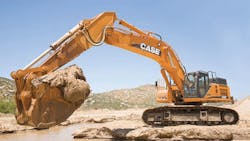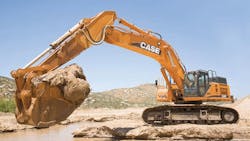Making a leaner, meaner excavator
It's not often you can increase the power output of a machine while also making it more fuel efficient. But that's just what engineers have accomplished with the CX800B excavator from Case Construction. Of course, power and efficiency are closely tied to the engine. But because virtually all mechanical output of the machine comes from hydraulics, power and efficiency are also closely tied to those of the hydraulic system.
Power from the CX800B begins with its 958-in.3, 532-hp, six-cylinder diesel engine, which develops up to 1,659 lb-ft of torque at 1,500 rpm. The Tier III engine drives a pair of variable-displacement axial-piston hydraulic pumps, which provide motive power and power for implements. Each pump generates up to 132.1-gpm of flow and operates with a system relief pressure of 4,554 psig. When the CX800B needs a quick boost of power, system relief momentarily increases by about 10%.
Power management
That's a lot of hydraulic power, so valves are not actuated directly. Instead, a gear pump delivers 7.1 gpm of flow to provide pilot pressure to 638 psig for actuating valves and other hydraulic functions. Two sets of valves are configured with the pumps. A four-spool valve section operates the right track motor and the boom, bucket, and arm cylinders. The other pump supplies a five-spool valve section that operates the left track motor, second boom cylinder, arm cylinder, swing motor, and auxiliary functions.
Valves controlling the track motors incorporate counterbalance valves to prevent an overrunning when descending a hill, and valves controlling the boom cylinders incorporate antidrift valves.Each of the two axial-piston track motors features two-speed operation and drives a planetary- gear final drive for maximum travel speeds of 1.8 or 2.6 mph. The machine's swing motor can drive the turret at 6.4 rpm and incorporates a spring-applied, hydraulically released brake with bidirectional cushion-relief valves.
Hydraulics as an energy miser
Providing a fuel-efficient engine can only go so far for conserving energy. Reducing the amount of energy required of the engine can allow it to run at slower speeds, which can translate to big savings. Therefore, the CX800B provides three modes of work, each designed to deliver the type of power to serve the task at hand. When the machine's work capacity exceeds that of the load, the operator can run the machine in high-speed mode. Essentially, this trades off torque and force for speed, allowing the machine to work faster. Getting a job done faster means less fuel will be burned. But the CX800B is made for heavy work, so heavy work mode provides maximum power. However, most jobs require different combinations of speed and power, so an automatic mode allows the machine's load-sensing hydraulics to provide the best compromise between speed and power for the task at hand.
However, the single-most energy-efficient feature of the CX800B is its hydraulic fan drive, which helps conserve energy and reduce emissions. Performance of diesel engines is sensitive to operating temperature. An engine exhibits its highest power output per unit of fuel consumption within a relatively narrow range of temperatures. Likewise, a diesel engine produces the lowest amount of emissions per unit of power also within a relatively narrow temperature range. These two temperature ranges are not identical, but they do overlap. Therefore, operating the engine within this overlapping temperature range produces maximum fuel economy and minimum emissions.
To keep an engine operating within this range, the cooling system maintains a relatively constant engine temperature even though engine speed, load, ambient temperature, and other factors are changing. The CX800B uses a variable-speed hydraulic- fan drive to do just that.
The fan drive is powered by a hydraulic pump, which delivers pressurized fluid through control valves to hydraulic motor, which drives the fan. Being a centrifugal load, fan speed is a function of motor torque, so fan speed can be closely regulated by controlling pressure across the motor. A variety of sensors feed ambient temperature, engine-coolant temperature, and other parameters to a microprocessor that provides a control signal for the pressure-control valve. To prevent the machine's radiator from becoming clogged with dirt or debris, a directional-control valve in the fan-drive circuit can be activated to temporarily reverse the flow of air through the radiator to blow out any debris.
So not only does the hydraulic system operate efficiently in its own rite, its role in providing precise engine temperature makes the engine more fuel-efficient as well.


